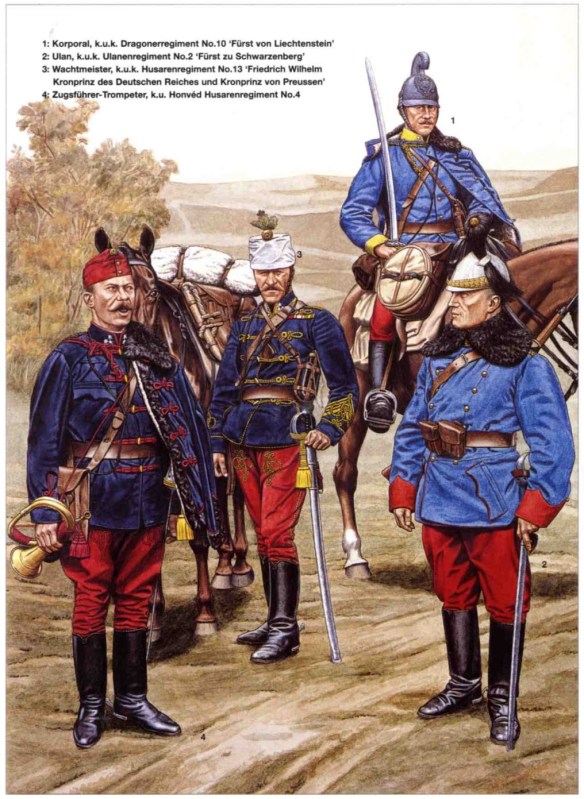
Pack-horse of a cavalry machine gun detachment; members of these and the telegraph detachments were the only cavalry troops to wear the pike-grey field uniform in 1914. The machine gun is the standard Schwarzlose M07/12; the tripod Is attached on the far side of the pack saddle, and note ammunition boxes for the 250-round belts on top. Infantry MG sections used pack mules.
In Vienna, there was a large gap between ideals and reality when it came to war. The poorly equipped Austro-Hungarian army was recruited from a great variety of ethnic groups, often with doubtful loyalty to the emperor. Mobilisation posters in 1914 came in 15 languages for an army that was 44% Slav, 28% German, 18% Hungarian, 8% Rumanian and 2% Italian, which created command problems between the German-dominated officer corps and the men. But the main difficulty in 1914 was the over-ambitious plans of the Austro-Hungarian commander, Conrad von Hötzendorf, whose lament that he deserved a better army was echoed by his men’s complaint that they deserved a better commander. Life in the Austro-Hungarian army is well described in Jaroslav Hašek’s book The Good Soldier Švejk.
THE CAVALRY
The cavalry was the most traditionalist and conservative arm on the Austro-Hungarian armed forces, some of the regiments tracing their lineage back as far as the Thirty Years’ War of the 17th century. The greatest modernizing reform of the cavalry units was instituted after 1867 when the heaviest arm, the Cuirassiers, were disbanded and these regiments were convened to Dragoons. Furthermore, the practical distinctions between heavy and light cavalry vanished, and the remaining three types of regiment – Dragoons, Hussars and Ulans (the Austrian spelling) – continued carrying the same arms consisting of carbines, revolvers (later semi-automatic pistols) and sabres only.
In 1914 they still wore their distinctive uniforms with helmets, shakos and czapkas, blue tunics, Attilas and Ulankas, all with red trousers (for Hussars, in Hungarian style). The Dragoon units were identified by different facing colours and buttons, while Hussars and Ulans were distinguishable by their shako and czapka colours. In the case of the Hussars half the regiments wore light blue uniforms (Attilas) and half dark blue; again, buttons in white or yellow metal made further distinctions. The Ulans all had madder-red collars and cuffs, and made further distinction by the top colours of the czapka and the button metal.
During the early years of the 20th century machine gun and telegraph detachments had been formed and specially trained. To some extent, the machine gun detachments of the Dragoons and Ulans were the only cavalry troops to wear a pike-grey field uniform in 1914.
The peacetime organisation counted 15 regiments of Dragoons, 16 regiments of Hussars and 11 regiments of Ulans (Nrs.1-8 and 11-13). The normal strength of a cavalry regiment comprised six squadrons with 900 horses. In wartime the regiments were organised in Kavalleriedivisionen, each consisting of four regiments separated into two cavalry brigades.
In addition to the Common Arm)’ cavalry, the k.k. Landwehr had six regiments of Ulans, a division of mounted Tyrolean Landesschützen and another of mounted Dalmatian Landesschützen (each of two squadrons). The Hungarian Honved included ten Hussar regiments, and additional squadrons of Hungarian Landsturm Hussars.
It became evident during the early stages of the war that these formations were destined to suffer great losses, Hastily, at least some field items were created, sometimes ‘on the pot’; the helmets of the Dragoons were either over-painted in grey or covered, with grey linen, as were the shakos of the Hussars and the czapkas of the Ulans; sabre scabbords were also sometimes over-painted grey. Paradoxically, many Ulans still wore the high horsehair plume and brass chin chain with their field-covered czapkas. A further step was the ‘overpainting’ of the trumpeters’ traditionally white horses; this led to some strange effects, like black-over-painted horses shining violet after the first contact with rain.
As the war continued it became difficult to supply remounts to keep up with the casualties among the horses, and each year a larger proportion of the cavalry were dismounted to serve as infantry in the trenches. Altough they were issued field-grey uniforms from the second half of 1915, photographs show officers and men still wearing the winter overcoats of their old coloured uniforms. In reality the summer and autumn of 1914 saw the swansong of this old arm of service. It was on 21 August 1914 at Jaroslavice that the Dragoons and Ulans of the 4.Kavalleriedivision fought with distinction against Cossacks, Dragoons, Hussars and Ulans of the Russian 10th Cavalry Division in what was later called the last true cavalry battle in history.